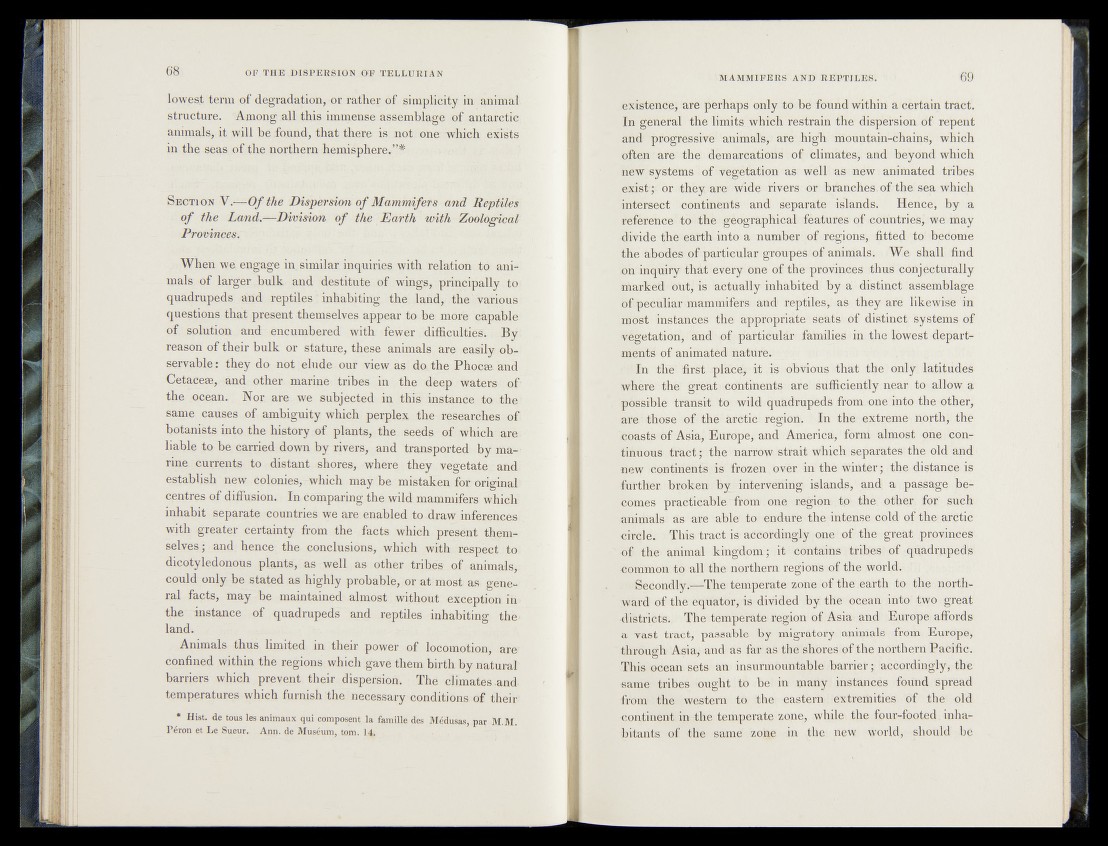
lowest term of degradation, or rather of simplicity in animat
structure. Among jail this immense assemblage of antarctic
animals, it will be found, th at there is not oner-which exists
in the seas, of the northern hemisphere.”*
S e c t io n V.— O f the Dispersion o f Mammifers and Reptiles
o f the Land.—Division o f the Earth with Zoological
Provinces.
When we. engage in similar inquiries with relation, to; animals,
of larger bulk and destitute of wings, principally i to?
quadrupeds and reptiles * inhabiting the land, the "various
questions that present themselves appear to-be more capable5
of solution and encumbered with fewer, difficulties; ; By :
reason of their bulk or stature, these animals are easily ob-s
servable : they do not elude our view as dot.the Phocse and
Cetaceæ, and other marine tribes in the deep waters- of-
the ocean. Nor are we subjected in this instance to the;
same causes of ambiguity which perplex the researches of.
botanists into the history of plants, the seeds of which .are •
liable to be carried down by rivers, and transported by marine
currents to distant shores, where , they vegetate and
establish new colonies,-which may be mistaken fo r original
centres of diffusion. In comparing the wild mammifers which!
inhabit separate countries we are enabled to draw inferences;
with greater certainty from the facts which present themselves
; and hence the conclusions, which with,! respect1 to;
dicotyledonous, plants, as well as other tribes of, animals,;
could only be stated as highly probable, or at most- as gene-f
ral facts, may be maintained almost without exception in
the instance of quadrupeds and reptiles inhabiting the*
land.
Animals thus limited in their power of locomotion, are1
confined within the regions, which gave them birth by natural
barriers which prevent, their dispersion. The climates-and
temperatures which furnish the necessary conditions of their
* Hist, de tous les animaux qui composent la famille des Médusas, par M.M.
Pérou et He Sueur. Ann. de Muséum, toftï. 14.
existence, are perhaps only to be found within a certain tract.
In general the limits_.which restrain the dispersion of repent
arid progressive' animal's, are :.high mountain-èhains, which
o ften 'a re 'th e demarcations of Climates, and beyond which
new systems > of vegetation as well as new animated tribes
exist;; or-éh^y-are-wide> rivers dr branches, of .’the. sea whicll'
intersect ' continents and separate islands. Hence, by a
reference to the géographioaluféatures of countries,' we may
divide the earth into a/mumber of1 regions, fitted to’ become
the abodes of particular groupes «of animals; W!e- shall find
,on .inquiry that every " one of the p rovinc.es thus conjpcturally
marked out/ is factually inhabited by a distinct assemblage
of peculiar mammifers-and reptiles^! as they are libe^^fe in
most: fnstancëlfHhè appropriate ^sa-tss’of distinet-systems of
•végétation, and -of particular families in the lowest departments
of aniinatèd nature.
In tlwF'-firët .placed it .is obvions that tlfe 1 oplyl latitudes
Wh-ère the great "cdhtinents • are sufficiently ; near to allow a
possiMei transit t o wild quadrupeds from, one!into the other,
are those of the " Arctic' region. In th e extreme north, thé;-
coasts of Akiâ/ Eurôpe^ànd America, 'form almost one continuous,
tract ; the narrow strait which separates-the old and
new 'ContMÉefs^ frozen.over.in the winter; the distancées
further brtoken by_ intervening islands, and; a passage be-
femes practicable^from .one -region .to the. other for such
animals-: as'are able to endurethe.infcense.cqld of the- arctic
circle* > This tract is accordingly^one^of- tile great provinces
o f . the animal kingdom:; .it contains tribes.5 of quadrupeds
common to all the northern, region's of the world. '
tri^econdly.—The temperate zone of the .earth to the northward
of the equator, is divided by thevoçeari into; two great
•districts. The temperate region of Asia and Europe affords
a vast tract, passable by migratory animals from Europe,
through Asia/ andras far as théshbres.'of the northern Pacific.
This ocean; sets an insurmountable barrier ; accordingly, the
same tribes ought to be* W m a n y instances found spread
from the western tê the; eastern extreiriitias of the old
-continent in-the temperate zone, while. .the four-footed, inhabitants
of the same zone in the new world, should be